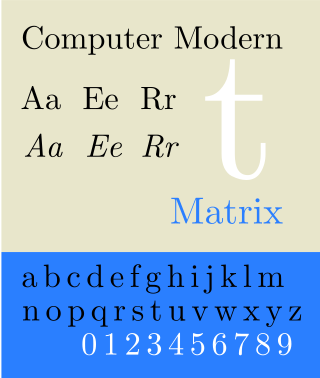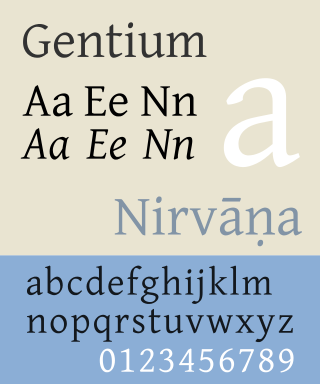
The Deseret alphabet is a phonemic English-language spelling reform developed between 1847 and 1854 by the board of regents of the University of Deseret under the leadership of Brigham Young, the second president of the Church of Jesus Christ of Latter-day Saints. George D. Watt is reported to have been the most actively involved in the development of the script, as well as being its first serious user.
TeX, stylized within the system as TeX, is a typesetting system which was designed and written by computer scientist and Stanford University professor Donald Knuth and first released in 1978. TeX is a popular means of typesetting complex mathematical formulae; it has been noted as one of the most sophisticated digital typographical systems.

A typeface is a design of letters, numbers and other symbols, to be used in printing or for electronic display. Most typefaces include variations in size, weight, slope, width, and so on. Each of these variations of the typeface is a font.
OpenType is a format for scalable computer fonts. Derived from TrueType, it retains TrueType's basic structure but adds many intricate data structures for describing typographic behavior. OpenType is a registered trademark of Microsoft Corporation.

The device independent file format (DVI) is the output file format of the TeX typesetting program, designed by David R. Fuchs and implemented by Donald E. Knuth in 1982. Unlike the TeX markup files used to generate them, DVI files are not intended to be human-readable; they consist of binary data describing the visual layout of a document in a manner not reliant on any specific image format, display hardware or printer. DVI files are typically used as input to a second program which translates DVI files to graphical data. For example, most TeX software packages include a program for previewing DVI files on a user's computer display; this program is a driver. Drivers are also used to convert from DVI to popular page description languages and for printing.

In typography, kerning is the process of adjusting the spacing between characters in a proportional font, usually to achieve a visually pleasing result. Kerning adjusts the space between individual letterforms, while tracking (letter-spacing) adjusts spacing uniformly over a range of characters. In a well-kerned font, the two-dimensional blank spaces between each pair of characters all have a visually similar area. The term "keming" is sometimes used informally to refer to poor kerning.

Courier is a monospaced slab serif typeface. The typeface was designed by Howard "Bud" Kettler (1919–1999). Initially created for IBM's typewriters, it has been adapted for use as a computer font, and versions of it are installed on most desktop computers.

Computer Modern is the original family of typefaces used by the typesetting program TeX. It was created by Donald Knuth with his Metafont program, and was most recently updated in 1992. Computer Modern, or variants of it, remains very widely used in scientific publishing, especially in disciplines that make frequent use of mathematical notation.

Gentium is a Unicode serif typeface designed by Victor Gaultney. Gentium fonts are free and open source software, and are released under the SIL Open Font License (OFL), which permits modification and redistribution. Gentium has wide support for languages using the Latin, Greek, and Cyrillic alphabets, and the International Phonetic Alphabet (IPA). Gentium Plus variants released since November 2010 now include over 5,500 glyphs and advanced typographic features through OpenType and formerly Graphite.

AMS Euler is an upright cursive typeface, commissioned by the American Mathematical Society (AMS) and designed and created by Hermann Zapf with the assistance of Donald Knuth and his Stanford graduate students. It tries to emulate a mathematician's style of handwriting mathematical entities on a blackboard, which is upright rather than italic. It blends very well with other typefaces made by Hermann Zapf, such as Palatino, Aldus and Melior, but very badly with the default TeX font Computer Modern. All the alphabets were implemented with the computer-assisted design system Metafont developed by Knuth. Zapf designed and drew the Euler alphabets in 1980–81 and provided critique and advice of digital proofs in 1983 and later. The typeface family is copyright by American Mathematical Society, 1983. Euler Metafont development was done by Stanford computer science and/or digital typography students; first Scott Kim, then Carol Twombly and Daniel Mills, and finally David Siegel, all assisted by John Hobby. Siegel finished the Metafont Euler digitization project as his M.S. thesis in 1985.
The internationalized domain name (IDN) homograph attack is a way a malicious party may deceive computer users about what remote system they are communicating with, by exploiting the fact that many different characters look alike. For example, a regular user of example.com may be lured to click a link where the Latin character "a" is replaced with the Cyrillic character "а".
The Chinese character description languages are several proposed languages to most accurately and completely describe Chinese characters and information such as their list of components, list of strokes, their order, and the location of each of them on a background empty square. They are designed to overcome the inherent lack of information within a bitmap description. This enriched information can be used to identify variants of characters that are unified into one code point by Unicode and ISO/IEC 10646, as well as to provide an alternative form of representation for rare characters that do not yet have a standardized encoding in Unicode or ISO/IEC 10646. Many aim to work for Kaishu style and Song style, as well as to provide the character's internal structure which can be used for easier look-up of a character by indexing the character's internal make-up and cross-referencing among similar characters.

A video synthesizer is a device that electronically creates a video signal. A video synthesizer is able to generate a variety of visual material without camera input through the use of internal video pattern generators. It can also accept and "clean up and enhance" or "distort" live television camera imagery. The synthesizer creates a wide range of imagery through purely electronic manipulations. This imagery is visible within the output video signal when this signal is displayed. The output video signal can be viewed on a wide range of conventional video equipment, such as TV monitors, theater video projectors, computer displays, etc.

Linux Libertine is a digital typeface created by the Libertine Open Fonts Project, which aims to create free and open alternatives to proprietary typefaces such as Times New Roman. It is developed with the free font editor FontForge and is licensed under the GNU General Public License and the SIL Open Font License.
The Cork encoding is a character encoding used for encoding glyphs in fonts. It is named after the city of Cork in Ireland, where during a TeX Users Group (TUG) conference in 1990 a new encoding was introduced for LaTeX. It contains 256 characters supporting most west and east-European languages with the Latin alphabet.

Golan Levin is an American new media artist, composer, performer and engineer interested in developing artifacts and events which explore supple new modes of reactive expression.
Ascender Corporation was a digital typeface foundry and software development company located in the Chicago suburb of Elk Grove Village, Illinois in the United States. It was founded in 2004 by a team of software developers, typographers, and font-industry veterans who had previously been involved in developing fonts used widely in computers, inkjet printers, phones, and other digital technology devices. On December 8, 2010, Ascender Corp. was acquired by Monotype Imaging.
Wilber Moore Stilwell (1908–1974) was an American depression era artist, White House/National Gallery of Art/American Artists Professional League honoree, inventor, patent holder, author, and Chair of Art, University of South Dakota.

Jonathan Bird is an American photographer, cinematographer, director and television host. He is best known for his role as the host of Jonathan Bird's Blue World, a family-friendly underwater exploration program on public television in the United States. His work is largely underwater in nature.
Just van Rossum is a Dutch typeface designer, software developer, and professor at the Royal Academy of Art in the Hague. He is the co-founder of design firm, LettError, along with Erik van Blokland. Just van Rossum is the younger brother of Guido van Rossum, creator of the Python programming language.












